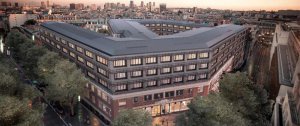Bio-adhesive lipid membranes on DNA carpets : confinement, depletion and localized pressure
It has been recently shown[1] that when a bio-adhesive phospholipid vesicle is brought into contact with a carpeted surface of end-grafted lambda-phage DNAs, the spreading front of the adhesive patch propagates outwards from a nucleation center, acting as a scraper that strongly stretches the DNA chains. Moreover, the multiple bonds created during vesicle spreading effectively staple the stretched chains in the gap between the membrane and the substrate, creating a tunnel-like channel for the DNA chains. The chain configuration starts thus at its fixed, end-grafted point at the streptavidin substrate, a protein layer of the receptors conjugate to the ligand biotin that end-functionalizes the short polymers to some of the bilayer phospholipids. From its grafted end, the chain meanders through the forest of short polymer bonds that connect the phospholipid membrane above the chain to the protein bed below it, eventually exiting the adhesive gap to adopt a coil-like configuration in the corner between the vertical vesicle wall and the protein surface. Such an experimental geometry provides an unique tool for studying single DNA stretching and confinement in a biomimetic environment[2].
In this lecture I will review the experimental conditions for realizing such confinement environment and will provide the theoretical background required to analyze the conformations of single and double end-grafted DNA chains in the neighborhood of the, almost vertical, phospholipids walls at the border of the adhesive patch[3]. Average images of the fluorescence emitted by these chains allowing for a direct visualization of the segment distribution of polymer chain conformations in restricted geometries, the observed DNA segment distributions and the observed membrane deformations can be quantitatively compared to the predictions from polymer and membrane theory.
[1] - Hisette M.L., Haddad P., Gisler T., Marques C.M., Schröder A.P., Soft Matter, 4, 828 (2008).
[2] - Nam, G., Hisette, M.L., Sun, Y. L., Gisler, T., Johner, A., Thalmann, F. ; Schröder, A.P., Marques, C.M., Lee, N.K. Phys. Rev. Lett., 105, 088101 (2010).[Cover story]
[3] - Thalmann, F. ; Billot, V. ; Marques, C.M. Phys. Rev. E, 83, 061922 (2011).








